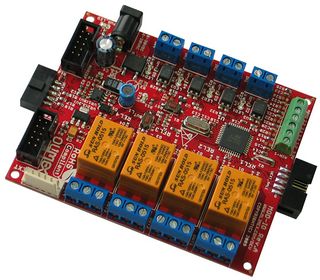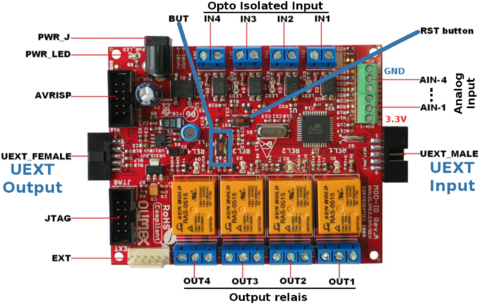Différences entre versions de « MICROPYTHON-MOD-IO »
| Ligne 4 : | Ligne 4 : | ||
[[Fichier:MICROPYTHON-MOD-IO-01.jpg|320px]] | [[Fichier:MICROPYTHON-MOD-IO-01.jpg|320px]] | ||
| − | MOD-IO is a stackable development board which adds analog and digital inputs and outputs to any of our development boards with UEXT. If you work with any of our development boards with a UEXT connector and you need more digital and analog inputs and outputs, you can add these by connecting MOD-IO to your development board. This board allows easy interfacing to 4 relays, 4 optoisolated digital inputs, 4 analog inputs. MOD-IO is stackable and addressable, what does this mean? It means that these boards can plug together so that you can add as many inputs and outputs as you want! E.g. 2-4-6-8 etc.! The MOD-IO has an ATmega16 microcontroller and the firmware is available for modification. | + | {{pl|1408|MOD-IO}} is a stackable development board which adds analog and digital inputs and outputs to any of our development boards with UEXT. If you work with any of our development boards with a UEXT connector and you need more digital and analog inputs and outputs, you can add these by connecting MOD-IO to your development board. This board allows easy interfacing to 4 relays, 4 optoisolated digital inputs, 4 analog inputs. MOD-IO is stackable and addressable, what does this mean? It means that these boards can plug together so that you can add as many inputs and outputs as you want! E.g. 2-4-6-8 etc.! The MOD-IO has an ATmega16 microcontroller and the firmware is available for modification. |
[[Fichier:MICROPYTHON-MOD-IO-02.png|480px]] | [[Fichier:MICROPYTHON-MOD-IO-02.png|480px]] | ||
| Ligne 19 : | Ligne 19 : | ||
Voyez {{pl|1408|notre fiche produit pour plus d'informations}}, schéma, utilisation OlinuXino, etc. | Voyez {{pl|1408|notre fiche produit pour plus d'informations}}, schéma, utilisation OlinuXino, etc. | ||
| + | |||
| + | == Matériel Utilisé == | ||
| + | Pour réaliser ce test, nous avons utilisé: | ||
| + | |||
| + | {{parts-begin}} | ||
| + | |||
| + | {{parts-item | ||
| + | |name=ESP8266-EVB | ||
| + | |descr=ESP8266 Evaluation Board d'Olimex | ||
| + | |img=ESP8266-EVB.jpg | ||
| + | |link=http://shop.mchobby.be/product.php?id_product=668 | ||
| + | |qty=1 | ||
| + | }} | ||
| + | |||
| + | {{parts-item | ||
| + | |name=MOD-IO | ||
| + | |descr=Carte MOD-IO d'Olimex | ||
| + | |img=MOD-IO.jpg | ||
| + | |link=http://shop.mchobby.be/product.php?id_product=1408 | ||
| + | |qty=1 | ||
| + | }} | ||
| + | |||
| + | {{parts-item | ||
| + | |name=UEXT-SPLITTER | ||
| + | |descr=Multiplicateur de port UEXT. Permettra de brancher la carte + Interface USB-Serie | ||
| + | |img=UEXT-SPLITTER.jpg | ||
| + | |link=http://shop.mchobby.be/product.php?id_product=1412 | ||
| + | |qty=1 | ||
| + | }} | ||
| + | |||
| + | {{parts-item | ||
| + | |name=USB-SERIE-TTL | ||
| + | |descr=Un cable console pour pouvoir communiquer avec l'ESP8266 | ||
| + | |img=USB-SERIE-TTL.jpg | ||
| + | |link=http://shop.mchobby.be/product.php?id_product=144 | ||
| + | |qty=1 | ||
| + | }} | ||
| + | |||
| + | {{parts-begin}} | ||
== Où acheter == | == Où acheter == | ||
Version du 10 octobre 2018 à 10:54
Introduction
|
|
En cours de traduction/élaboration. |
MOD-IO is a stackable development board which adds analog and digital inputs and outputs to any of our development boards with UEXT. If you work with any of our development boards with a UEXT connector and you need more digital and analog inputs and outputs, you can add these by connecting MOD-IO to your development board. This board allows easy interfacing to 4 relays, 4 optoisolated digital inputs, 4 analog inputs. MOD-IO is stackable and addressable, what does this mean? It means that these boards can plug together so that you can add as many inputs and outputs as you want! E.g. 2-4-6-8 etc.! The MOD-IO has an ATmega16 microcontroller and the firmware is available for modification.
It features:
- Open source hardware board with ATmega16L-8AU microcontroller à 8 MHz.
- EXT extension connector
- Status LED
- Reset IC ZM33064 to protect the board againt low voltage running.
- Power plug-in jack, DC-DC with input voltage 8-30VDC (compatible avec les alimentations industrielles 24V)
- 4-optocoupler isolated inputs with screw terminals with Input status LEDs
- 4-relay outputs with 5A/250VAC contacts with screw terminals with Output status LEDs
- Dimensions 80x100 mm
Voyez notre fiche produit pour plus d'informations, schéma, utilisation OlinuXino, etc.
Matériel Utilisé
Pour réaliser ce test, nous avons utilisé:
| Description | Quantité | ||||
| ESP8266-EVB 250px |
ESP8266 Evaluation Board d'Olimex disponible ici chez MCHobby |
1 | |||
| MOD-IO 250px |
Carte MOD-IO d'Olimex disponible ici chez MCHobby |
1 | |||
| UEXT-SPLITTER 250px |
Multiplicateur de port UEXT. Permettra de brancher la carte + Interface USB-Serie disponible ici chez MCHobby |
1 | |||
| USB-SERIE-TTL 250px |
Un cable console pour pouvoir communiquer avec l'ESP8266 disponible ici chez MCHobby |
1
|

